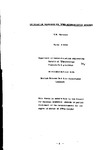OPTIMISATION TECHNIQUES FOR TELECOMMUNICATION NETWORKS
| dc.contributor.author | GROUT, V.M. | |
| dc.contributor.other | School of Engineering, Computing and Mathematics | en_US |
| dc.date.accessioned | 2013-11-21T14:31:23Z | |
| dc.date.available | 2013-11-21T14:31:23Z | |
| dc.date.issued | 1988 | |
| dc.identifier | NOT AVAILABLE | en_US |
| dc.identifier.uri | http://hdl.handle.net/10026.1/2806 | |
| dc.description.abstract |
This thesis deals with various facets of the optimisation problem for telecommunication networks and proposes a number of new techniques for their solution. The necessary essentials, Graph Theory, Complexity Theory and Telecommunication Principles, are investigated. The relevant graphs are enumerated and the requirements of suitable optimisation algorithms for certain graphical problems are established. The Private Automatic Branch Exchange (PABX) is introduced. the variety of telecommunications traffic as well as the practical requirements of a connection topology are discussed. The fundamental Network Optimisation Problem (NJP) is defined and analysed. Simple exhaustive methods of solution are considered together with partial solution algorithms and simplification methods. Centralised networks with and without concentrators are introduced. Extensions and modifications are proposed for some techniques and existing practical methods of dealing with the NOP are investigated. A number of new ideas are proposed for the practical solution of the NOP. Reduction methods are presented for replacing large unmanageable networks with smaller ones, on which optimisation can take place. Fixed topology techniques are introduced for initial tandem switch selection purposes and perturbation methods are considered which can be applied to such an initial solution. Lookahead methods of link removal are introduced for the purposes of determining the tandem interconnection network together with the traffic routeing strategy. A composite method is proposed incorporating all of these concepts and the results of a number of numerical experiments upon actual network problem; are presented. the extension of the proposed techniques to other areas of problem solving and optimisation is considered. In particular, a new method for the solution of the Euclidean Travelling Salesman Problem (ETSP) is presented. A brief discussion is undertaken, in conclusion, concerning the practical difficulties of the NOP and The restrictions this placed upon solution algorithms of various types. | en_US |
| dc.description.sponsorship | Brit1sh Telecom, Ta1lis Consultancy, London | en_US |
| dc.language.iso | en | en_US |
| dc.publisher | University of Plymouth | en_US |
| dc.title | OPTIMISATION TECHNIQUES FOR TELECOMMUNICATION NETWORKS | en_US |
| dc.type | Thesis | |
| plymouth.version | Full version | en_US |
| dc.identifier.doi | http://dx.doi.org/10.24382/3272 | |
| dc.identifier.doi | http://dx.doi.org/10.24382/3272 |
Files in this item
This item appears in the following Collection(s)
-
01 Research Theses Main Collection
Research Theses Main


